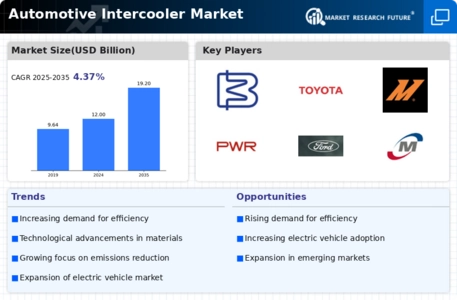Top Industry Leaders in the Automotive Intercooler Market
The automotive intercooler market thrives on the demand for peak engine performance, notably with the surge of turbocharged and high-performance vehicles. In this competitive domain, both established leaders and ambitious newcomers strive for market dominance, each aiming to develop the most efficient and robust cooling solutions. Let's explore the primary strategies, driving forces, and emerging trends steering this dynamic competition.
Strategies Employed by Key Players:
Product Diversification: Industry leaders like Behr Hella Thermocontrol and Mahle are diversifying their product ranges beyond conventional tube-and-fin intercoolers. They're introducing high-performance bar-and-plate designs, lightweight composite materials, and integrated cooling systems tailored for specific engine types and vehicle applications. This diversification caters to diverse performance and efficiency demands.
Technological Innovation: Continuous research and development drive progress. Companies like Mishimoto lead the charge, exploring advanced materials like nanocoatings and flow optimization software to enhance heat transfer and reduce pressure loss. This technological edge disrupts the market, appealing to performance-oriented customers.
Vertical Integration: Major players like BorgWarner venture into core manufacturing, producing their intercoolers and related components. This integration ensures quality control and potentially enables competitive pricing strategies.
Global Reach and Partnerships: Players like Valeo establish manufacturing facilities and regional partnerships to cater to diverse markets. This localized approach ensures proximity to customers and minimizes logistical challenges.
Factors Impacting Market Share:
Performance and Efficiency: The effectiveness of an intercooler relies on rapidly cooling compressed air without affecting airflow. Players like Forge Motorsport stand out with high-flow designs and low pressure drops, offering optimal engine performance and fuel economy.
Durability and Reliability: Intercoolers operate in harsh environments, so companies like Bell Intercoolers prioritize robust materials and stringent quality control measures to ensure longevity and consistent performance, building customer trust and loyalty.
Cost-Effectiveness: While advanced features are desirable, cost remains a significant factor, especially in budget-sensitive segments. Players like Kale Oto Radyator develop cost-competitive intercoolers through optimized designs and efficient manufacturing processes, appealing to a wider range of manufacturers.
Sustainability Focus: Environmental responsibility gains traction. Toyota pioneers lightweight and compact intercoolers that minimize material usage and enhance overall vehicle fuel efficiency, aligning with industry sustainability goals and attracting environmentally conscious consumers.
Emerging Trends:
Active Intercoolers: Incorporating sensors and actuators enables dynamic airflow control within the intercooler. Companies like Mishimoto lead in this technology, adjusting cooling based on engine load and ambient temperature, optimizing performance and potentially improving fuel economy.
Electric Vehicle Intercoolers: With the rise of electric vehicles, the demand for high-efficiency thermal management systems grows. Companies like Valeo develop dedicated intercoolers for electric motors and battery packs, ensuring optimal operating temperatures and extending battery life.
3D Printing and Advanced Manufacturing: Additive manufacturing allows designing custom intercoolers with complex geometries and improved flow characteristics. Companies like Ford explore 3D-printed intercooler cores, potentially enabling lighter, more efficient designs in the future.
Competitive Landscape Overview:
The automotive intercooler market is dynamic and fiercely competitive, propelled by technological advancements, the pursuit of peak engine performance, and the expanding electric vehicle segment. Established players with broad product portfolios, technological leadership, and global reach are well-positioned to benefit from this growth. Yet, new technologies, materials, and manufacturing techniques continuously reshape the landscape. Players adapting quickly, embracing innovation, developing cost-effective solutions for specific applications, and contributing to sustainable initiatives will secure a lasting competitive advantage in this high-performance race.
Recent Industry Developments:
Bell Intercoolers:
-
October 2023: Launched the new "Chill Factor Pro" series of intercoolers for high-performance applications, boasting increased core area and improved flow efficiency.
Forge Motorsport Inc:
-
December 2023: Unveiled the "FMIC10" prototype, a lightweight and compact front-mount intercooler for the latest BMW M3/M4 models.
Kale Oto Radyator:
-
December 2023: Announced expansion into the European market with the appointment of a new distributor in Germany.
Toyota:
-
November 2023: Showcased the GR Corolla at the SEMA show, featuring a unique top-mounted intercooler setup for enhanced cooling performance.
Mishimoto:
-
December 2023: Offered Black Friday discounts on a wide range of performance intercoolers and related components.
PWR:
-
December 2023: Announced a partnership with Australian motorsport team Walkinshaw Andretti United for the 2024 Supercars Championship season.
Leading Companies in the Automotive Intercooler Industry:
- Bell Intercoolers
- Forge Motorsport Inc
- Kale Oto Radyator
- Toyota
- Mishimoto
- PWR
- Ford
- Modine Manufacturing
- JC Performance Parts
- KVR International
- PT Toyota-Astra Motor (TAM)
- And others

